




1.0 Components
2.0 The Cards
3.0 Setting Up and Winning the Game
4.0 Army Organization
5.0 Sequence of Play
6.0 Conducting Battles
7.0 Scenario Instructions
8.0 Design Notes
9.0 Example of Play
In 1814, the Emperor Napoleon was forced to abdicate, banished to the Mediterranean island of Elba. Louis XVIII was restored to his throne by the victorious Coalition of Austria, Russia, Prussia and Great Britain. It was to be a restoration of short duration. Napoleon escaped from Elba and landed at Cannes on March 1st, 1815. Day one of the Hundred Days.

Napoleon headed for Paris, gathering troops as he went. In a famous incident outside Grenoble, Napoleon was confronted by forces sent by the king to apprehend him. He addressed them directly, baring his chest and saying “if any of you will shoot his Emperor, here I am.” None did. In an equally famous incident, the Emperor’s former lieutenant, Marshal Ney, marched south, vowing to deliver the former emperor to King Louis “in an iron cage”. On March 14th Ney went over to Napoleon.
The leaders of the major European powers, busy carving up post-Napoleonic Europe at the Congress of Vienna, mobilized their armies to suppress the resurgent Emperor, planning a multinational invasion, set for July 1st. The most immediate threat was a pair of Coalition armies in Belgium, hard against the French border. These consisted of an Anglo-Allied force of 112,000 men, led by the Duke of Wellington, deployed in and around Brussels, and a Prussian army of 130,000 men, commanded by Napoleon’s aging nemesis Marshal Blücher, deployed around Namur. Austrian columns began concentrating along France’s southern borders, while a massive Russian army of 250,000 men set out for the French frontier.
Aiming to destroy his closest enemies first, Napoleon assembled an army of 123,000 men, christened the Army of the North (l’Armée du Nord), south of the Belgian border near the town of Charleroi. When Napoleon crossed the border on June 14th, Prussian General von Zieten’s I Corps staged a fighting withdrawal to Blücher’s assembly area. Napoleon threw the main force of his army against the Prussians, fighting a battle outside the town of Ligny. Blücher was driven from the field by nightfall. The French pursuit fell to Marshal Grouchy, who lost track of the Prussians during the 17th. Eventually, it became clear that, rather than retreating towards their supply center at Namur, the Prussians had marched north, where they could support Wellington’s rapidly assembling army. Though the Prussians had been bloodied at Ligny, time would reveal that they had not, as Napoleon supposed, been shattered.
Napoleon turned his attention to the Duke of Wellington, pushing up the Charleroi-Brussels road on June 17th in an attempt to bring the British army to battle. The final clash of the Napoleonic era was about to begin, south of a town called Waterloo….
Napoleon’s Eagles: The Hundred Days features the four pivotal battles fought on the 16th and 18th of June, 1815. The battles of the 16th: Quatre Bras and Ligny, and the final battles on the 18th: Wavre and Waterloo. The game includes two campaign scenarios, in which a pair of battles is fought together, plus a 3-day campaign game that links all four battles into one game.
The intent of Napoleon’s Eagles: The Hundred Days, is to present a Napoleonic battle game in which the largest of period battles can be played to completion in an evening. While there are multiple scenarios presented in the game, each with its own special rules and conditions for victory (7.0), most scenarios are won by inflicting nine demoralizations on your opponent’s army. Combat is a back and forth affair, using specially designed decks of playing cards. Combat is simple, fast and straightforward, but has a number of subtle wrinkles that you’ll discover during play. Units represent infantry and cavalry formations, massed artillery formations, and those leaders operating at the highest levels (army and wing commanders).
About the 2nd Edition
For owners of Napoleon’s Eagles: Storm in the East, all changes from the 1st Edition rulebook are included in these rules in blue. These changes are applicable to scenarios in Storm in the East. Included with this game are eight replacement playing cards for Storm in the East (the backs of which are different from the playing cards in The Hundred Days).
© 2021Compass Games, LLC.
Each Napoleon’s Eagles game consists of battle cards, playing cards, informational cards and a set-up chart. Unit cards are unique to each historical scenario, the playing cards are common to all scenarios. Contents of this game are:
• 1 rulebook
• 2 identical player aid charts
• 2 set-up cards
• 1 deck of 65 Battle Cards
• 8 leaders
• 13 terrain cards
• 21 French combat units
• 11 Allied combat units
• 12 Prussian combat units
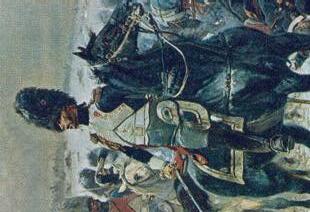



• 1 deck of 52 French Playing Cards
• 1 deck of 52 Coalition Playing Cards
• 1 deck of 25 Other Cards
• 5 Reserve
• 7 Front Line
• 4 Demoralized
• 4 Flanked
• 2 Hors de Combat
• 3 Turn
• 1 box and lid set
• 8 replacement cards for Napoleon’s Eagles: Storm in the East
Napoleon’s Eagles uses cards for all game functions. There are four different types:
• Units cards (2.1)
• Terrain cards (2.2)
• Playing cards (2.4)
• Information cards (2.5)
2.1.1 Types. There are two types of Unit cards:
• Combat units representing military forces
• Leaders representing the major commanders in each battle.
Unit cards contain information used in the game, and follow the graphic format shown below. See the player aid card for unit card information examples.
2.1.2 Combat Units. Combat units in Napoleon’s Eagles consist of infantry and cavalry formations, and ad-hoc units like artillery detachments. Note that some infantry combat units have cavalry support symbols (2.3.11), giving them potential combined arms (6.21) and charge capabilities (6.7).
Combat units begin the game both full strength (front side up) and ready (upright relative to the owner). During the game they may become disrupted (reverse side up) and exhausted (rotated 90 degrees relative to the owner).
2.1.3 Disrupted. When disrupted, a full-strength combat unit is flipped to the side showing a red “D” in the upper left-hand corner. A disrupted unit that is disrupted a second time is eliminated. Combat units may rally from disruption (flip back to their full-strength side) as a movement action (5.2.2).
2.1.4 Exhausted (Only Cards with the Infantry Symbol): Infantry combat units may become “exhausted”, indicated by rotating the card 90 degrees. Exhausted infantry combat units are automatically “readied” again during the Preparation Step by returning them to their original orientation. Only a ready infantry combat unit may exhaust voluntarily. An exhausted infantry combat unit which is exhausted a second time because of a check (2.4.4) becomes disrupted (and remains exhausted).
Exceptions: Garrisoned terrain cards (2.2.2) exhaust like infantry combat units. Infantry combat units with a gray infantry symbol may not exhaust voluntarily (2.3.7).
Either orientation is acceptable
© 2021 Compass Games, LLC.


2.1.5 Elimination. Disrupted units that suffer another disruption (including disrupted/exhausted infantry units that are exhausted again) are eliminated and removed from the game. Elimination of enemy units contributes to victory in some scenarios.
Design note: Infantry units can be both exhausted and disrupted. A disrupted and exhausted infantry unit which is “readied” during the Preparation Step remains disrupted and may be rallied to full-strength during the upcoming Movement step.
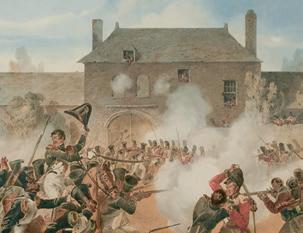





2.1.6 Leaders. Leaders are a type of unit card representing major commanders that provide benefits to their side during battle. They may occupy wings or reserves just like combat units, but do not count against stacking limits in wings, nor do they count against unit limits for moving in or out of wings or reserves. Leaders may stack with each other as desired by the owning player. Leaders may not occupy wings by themselves – they must immediately withdraw to the reserve the moment they are alone in a wing for any reason.
Design note: Some leaders may only end the movement step in a wing if accompanied by certain unit types (e.g. Murat must be with cavalry).
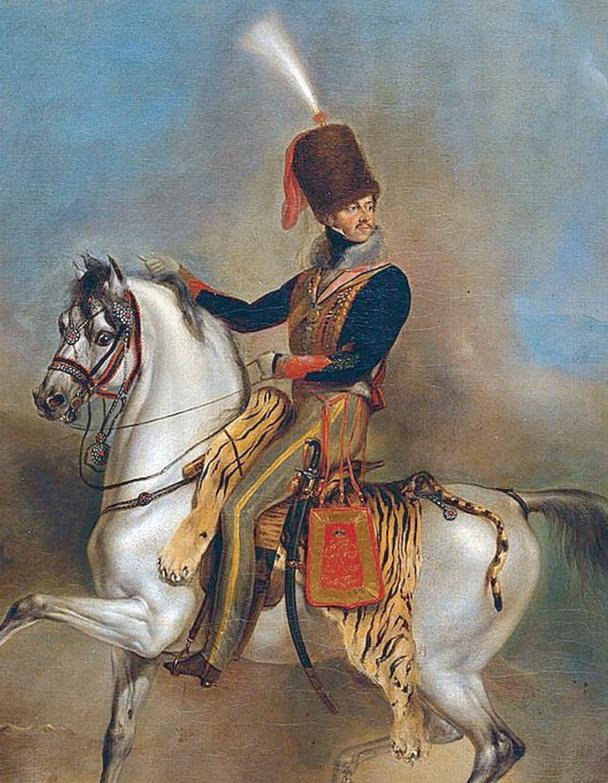
2.1.7 Leader Elimination. Leaders in wings where a battle is declared (5.3) are subject to elimination checks (6.4), which may result in a hors de combat or elimination result. Elimination of enemy leaders contributes to victory in some scenarios.
2.2.1 General. Terrain cards represent significant battlefield features (hills, villages, redoubts, etc.). They exist in wings like other units but may be controlled by either player and change sides back and forth during the game. Depending on the scenario, some terrain cards may not begin the battle in play. Terrain cards do not count for stacking and are never eliminated.
2.2.2 Garrisoned Terrain Cards. Terrain cards may have an infantry symbol (2.3.6). There are two such terrain cards in The Hundred Days: Germioncourt Farm at Quatre Bras, and Limale at Wavre. These cards, called garrisoned terrain cards, may be exhausted to play a melee card, absorb damage or absorb an artillery hit. They may not move, disrupt, retreat, or participate in breakthrough combat. Their infantry symbol counts toward combined arms.
Garrisoned terrain cards are not combat units. If one is in a wing without a friendly unit when an attack is declared, it is captured along with any other terrain in the wing.
2.2.3 Surrendering Terrain Cards. Terrain cards represent each army’s position on the battlefield. When a terrain card is surrendered due to a battle, it is said to be “captured” by the opposing player, and the card is physically moved across the front line card to the opposing wing. In some cases, a terrain card’s text may indicate it is flipped depending on which side captured it.
2.2.4 Deployment Icons: Each side of a terrain card has “deployment icons” that are matched to a player’s side of a Front Line card when a battle is declared (5.3). Flip the terrain card if necessary to match the icons. The deployment icons indicate the value of the terrain card for the owning side during the combat:
Advance Icon: This wing is advancing to make an attack.





The Hold Icon: This wing is defending against an attack.
Terrain Icon: Flip the card only if instructed to do so by the information on the terrain card.

Design note: When a player is defending terrain with the hold deployment icon, his side gains the benefits (or drawbacks in some cases) of the terrain being defended. When a player declares combat, he is advancing on the enemy (the advancing icon), so the effect of the terrain changes. Cards with the terrain icon indicate special cases.

Combat units and terrain cards have various symbols and numbers to indicate special abilities for battle, rallying, etc. Terrain cards may also have text that describes movement or battle restrictions depending on ownership and situation. Unless directed otherwise, special abilities only affect the player that controls the Combat unit or terrain card.
2.3.1 Orders. To use, leader must be in an incommand reserve (not wing) connected to a wing conducting combat. Orders rating allows owning player to draw indicated number of additional playing cards prior to combat. Leader may use orders rating for any number of eligible combats each turn. Wing that receives cards due to Orders may not also gain cards due to Leadership.
2.3.2 Leadership. At beginning of battle, each player may choose to use Leadership rating of one leader in his wing to draw that many additional cards into his hand. Wing that receives cards due to Leadership may not also gain cards due to Orders.
2.3.3 Manpower. Used to increase the value of a combat total on attack or defense. If several cards are played, modifier is added to the final total, not to each card individually. Manpower ratings of units change when they become disrupted. Rating used is the one visible when the final total is determined. If an attack or defense card is not played, Manpower ratings have no effect.
2.3.4 Initiative. Cards with black or red Initiative rating can change the color of cards played during battle resolution. Red Initiative rating can change color of any card to red. Black Initiative rating can change color of any card to black. Combined black and red Initiative can change color either way. Note when a combat unit is disrupted it may lose Initiative rating. Moment this happens player may no longer use the Initiative rating. Attack or defense cards which had their color changed by Initiative remain that color until discarded, even if the Initiative rating that shifted them disappears afterwards.
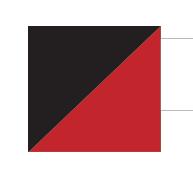
2.3.5 Aces Up. Units with this ability can change aces into the value shown. An Aces Up ability with the crossed muskets symbol allows aces to be played as melee cards (note they are removed from the game when played this way). Note that a friendly ready infantry in the wing must become exhausted in order to use this ability. If a wing contains more than one unit with the Aces Up ability, the owning player may use the
ability of whichever unit he chooses [but only one unit]. The Aces Up ability is valid at all times (during a charge, for instance).
2.3.6 Infantry Symbol. Combat units with this symbol are infantry units. Terrain cards with this symbol are garrisoned terrain (2.2.2). Only units and terrain cards with the infantry symbol can exhaust (2.1.4). A ready unit with the infantry symbol may exhaust voluntarily, either to absorb 3 points of damage from an attack (6.8), absorb damage from an artillery check, or to play a Melee card (6.6). Units and terrain cards with this symbol may become exhausted due to checks or retreats. Exhausted units automatically ready during the Preparation Step.
2.3.7 Gray Infantry Symbol. Combat units with this symbol are infantry units which may not exhaust voluntarily (to absorb damage from an attack or artillery check, or to play a Melee card). Units with this symbol may become exhausted due to checks or retreats. Exhausted units automatically ready during the Preparation Step.


2.3.8 Cavalry Symbol. Combat units with this symbol are cavalry units. They have special abilities that come into play during Breakthrough Attacks (6.12) and Charges (6.7).

2.3.9 Gray Cavalry Symbol. Combat units with this symbol are cavalry units, however they may not perform Charges (6.7).



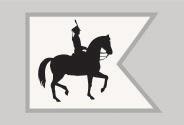


2.3.10 Artillery Symbol. Combat units with an artillery rating use it to bombard the enemy during pre-battle checks (6.3). Values of all friendly artillery ratings are added together for a single Artillery Check.



2.3.11 Cavalry Support Symbol. Infantry units with this symbol count as cavalry for combined arms, and may charge. They are not cavalry units.
2.3.12 Gray Cavalry Support Symbol. Infantry units with this symbol count as cavalry for combined arms, but may not charge. They are not cavalry units.
2.3.13 Guard.
Guard Infantry: Guard infantry units may be voluntarily exhausted normally, but ignore involuntary exhaustion resulting from a Check.
Guard Cavalry: Hors de Combat (HdC) results become withdrawals when performing checks. If the unit cannot withdraw (because it is already in reserve, for example), the HdC result becomes no effect.
Guard Artillery: Guard artillery has no additional abilities (but guard artillery ratings are higher than those of non-guard units).
2.3.14 Enhanced Melee. This rating allows a player to treat certain playing cards as Melee cards. The enhanced melee rating indicates the lowest value number card that must be played to declare a melee. Number cards used to initiate melee in this way are permanently removed from play, just like melee cards. Note that a friendly ready infantry in the wing must become exhausted in order to use this ability.
2.3.15 Rally in Place. Large formations could feed reserves into the Front Lines while maintaining contact with the enemy. Formations with this ability may make a Rally Check as a movement action, even while occupying a wing (5.2.3). If successful, the unit returns to full strength.
Each player has one full deck of playing cards, which is used to run the game. Opposing decks are never mixed. When the rules refer to “drawing a card,” it refers to a player’s deck of playing cards. A discard pile is formed beside the deck.
2.4.1 Reshuffling. Players reshuffle their discarded cards back into their deck at the beginning of every turn, and immediately during play if the deck is depleted.
2.4.2 Elimination. During the game, some playing cards may be “eliminated” (i.e. Melee cards that are removed from the game). These are placed to the side and are not included in reshuffles of the deck.
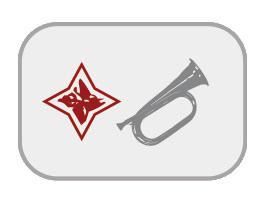
2.4.3 Use in Battle. Although playing cards contain several different pieces of information, during a battle only a card’s color and value is considered. Note that aces have a value of 1.
Napoleon’s
2.4.4 Making Checks. Whenever a player is called upon to make a “check”, a playing card is drawn and the appropriate section consulted to determine the outcome. Check types and purposes are listed below:
Recovery (6.14.1): During the Preparation Step when a combat unit or leader on a Hors de Combat (HdC) card attempts to return to play.

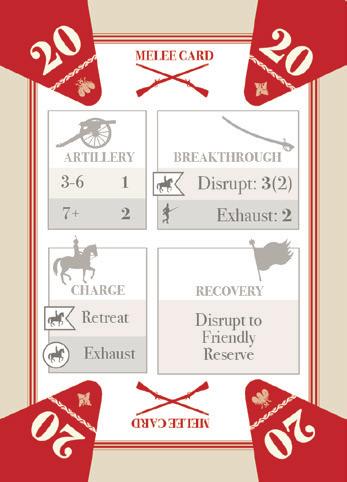
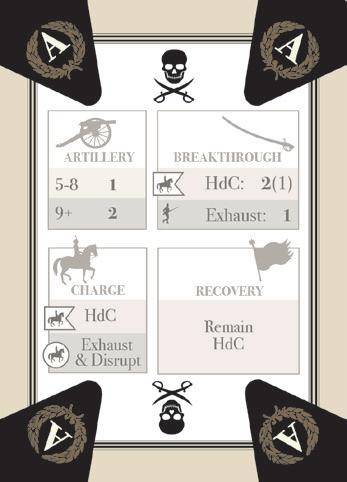

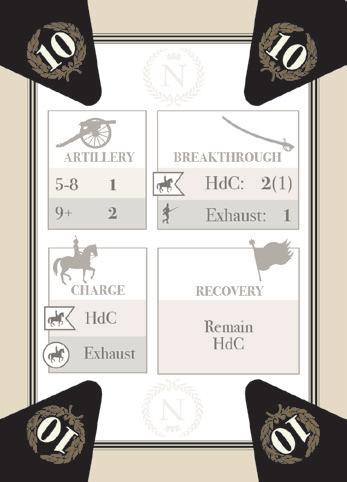


Rally (5.2.3): During Movement Step when a unit attempts to rally in an out of command reserve or attempts to Rally in Place in a wing.
Artillery Fire (6.3): At the start of a battle when firing artillery.
Elimination (6.4): During a battle for any leader in a wing.
Charge (6.7): During battle when a unit with a cavalry or cavalry support symbol charges.

Breakthrough (6.12.1): For each unit making or countering a breakthrough attack on a reserve at the end of a battle.


Entry (5.1.1): For reinforcements which must pass a check before entering play.
Sample Playing Card
Elimination
Artillery
Breakthrough
Charge Recovery Rally
In addition to unit and playing cards, there are a number of informational cards provided in the game:


2.5.1 Front Line Cards are placed between players to illustrate where their wings are, and to indicate which wings are initiating a battle each turn.


2.5.5 Demoralization Cards are tucked under a player’s deck as demoralizations accumulate. They are the primary way that victory is achieved.


Each scenario has a set-up chart that, along with the scenario instructions in the rulebook (7.0), guides play. The scenario rules and set up cards indicate where units and leaders may move, where they begin play, who is the first player and how many turns the scenario lasts.
To set up the game, each player receives a deck of playing cards along with the unit and leader cards that compose the army, and the terrain cards controlled by that army. Every scenario has scenario-specific rules, but all follow the same general outline:

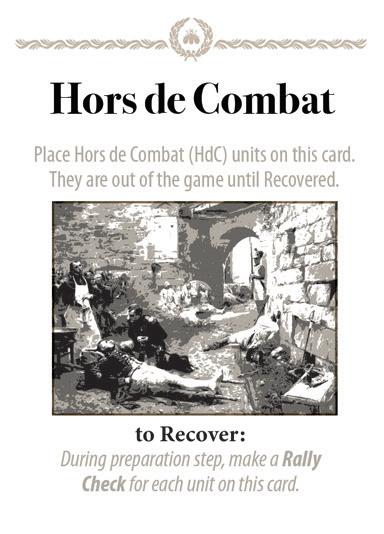
1. Place Front Line cards as indicated on the set-up chart, with their text facing the first player.
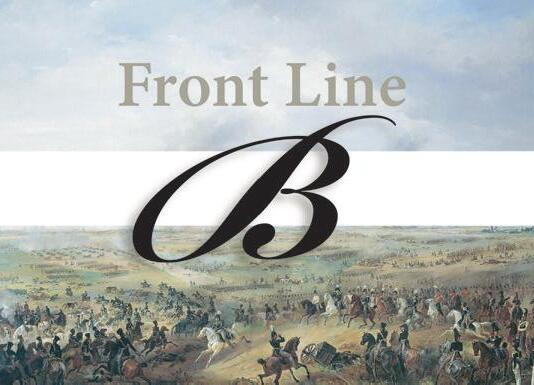
2. Place reserve cards behind their appropriate wings (2.5.2).

3. Place unit cards in their starting wings and reserves.
© 2021 Compass Games, LLC.


4. Set aside reinforcing combat units and leaders.
5. Place other Information cards nearby for later use (e.g. Flanked, Demoralized). Each player receives one HdC card.
6. Set the Turn Cards to turn 1.
7. The first player begins with the turn 1 Movement step (there is no Preparation step on turn 1).
In general, when a side receives 9 demoralizations (6.12.3), that player’s army is said to have broken and the opposing side wins the game. In addition to winning by breaking the opposing army, scenario instructions usually have other victory conditions that can determine a winner.
At the outset of a scenario, players set up Front Line cards between them, as indicated on the set-up chart. These cards, labeled A, B, C, etc., are set up sideways, with the letters oriented towards the first player. Reserve cards are set up to identify the reserves in each player’s “second line” of cards. During the game, players should arrange their unit cards relative to the Front Line and Reserve cards to make clear which wing or reserve they occupy.
Each Front Line card defines one “wing” of each army. Neither player controls a Front Line card; it acts as a separator between opposing wings.
4.1.1 Wings and Movement. Units occupying a wing cannot move directly to another wing, they can only move backwards to the reserve associated with that wing.
4.1.2 Wings and Battle. In game terms, a battle is one turn of combat between two opposing wings (French “C” wing vs Prussian “C” wing for example). Opposing wings do not conduct combat if neither player declares a battle for that wing.
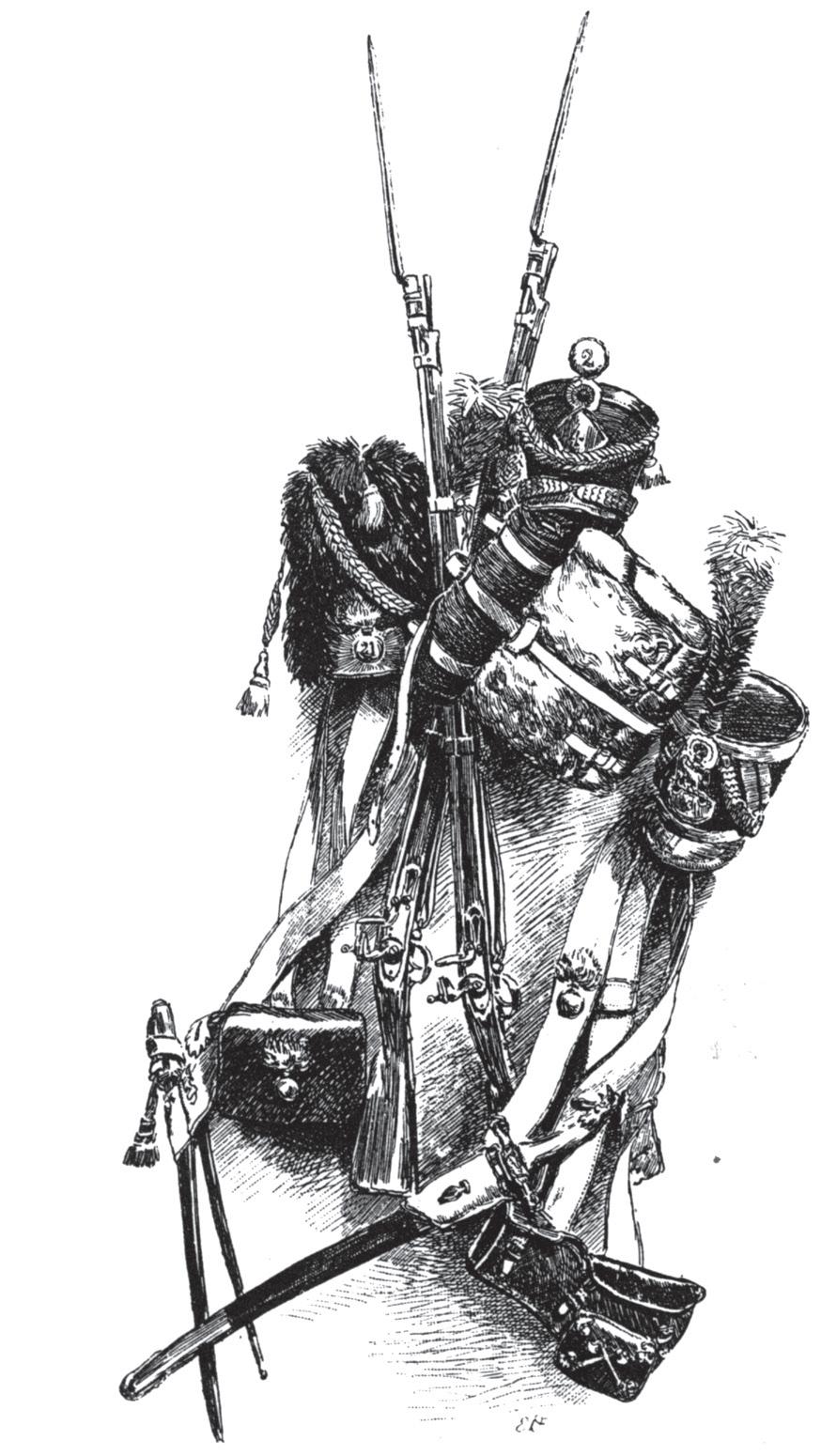
Every wing has a “reserve” associated with it, as indicated on the set-up chart. Several wings will often share a common reserve.

4.2.1 Reserves and Movement. Units in a wing may only move into the reserve with which it is associated and may only enter the wing from that reserve. Units may move from reserve to reserve if indicated on the set-up chart (a line connecting two reserves on the set-up chart means that units may move between them).
4.2.2 Out of Command. A reserve is in command unless a breakthrough attack placed it out of command during the prior turn’s battle resolution (6.12). An out of command reserve has its reserve card flipped to the Out of Command side and has the following penalties levied against it:
• Leaders in the reserve cannot issue orders (2.3)
• Units in the reserve attempting to become undisrupted must pass a Rally Check (5.2.3).
4.2.3 Returning to In Command. Out of Command reserves that are not subject to a successful breakthrough attack are returned to In Command (flipped back over) in the next turn’s Preparation Step.
© 2021Compass Games, LLC.
Some scenarios specify stacking limits, indicating the maximum number of unit cards which may occupy a wing. Leaders and Terrain cards do not count towards a wing’s stacking limit. Reserves never have stacking limits.
A game of Napoleon’s Eagles consists of a number of fourstep turns which continue until one player achieves victory, or the game’s duration (as set out in the scenario rules) is reached. Both players complete all actions for one step before moving on to the next. The first player, identified on the set-up chart, goes first in each step.
5.1 Preparation Step
5.2 Movement Step
5.3 Battle Declaration Step
5.4 Battle Resolution Step
At the beginning of every turn, both players follow the following sequence (note the Preparation Step is skipped in the first turn of the game):
a) Advance the turn card or end the game if the scenario’s duration has been reached.
b) Shuffle unused Playing card and discard piles to form a new deck.
c) All exhausted infantry units are readied (rotated back to upright).
d) Recovery checks are made for HdC units and leaders (6.14.1).
e) Out of command reserves that were not subject to successful breakthrough attacks last turn are returned to in command (flipped over).
f) Reinforcements arrive per scenario instructions.
5.1.1 Entry Checks. When a reinforcing unit is called upon to make an entry check, the owning player draws one (1) card. If the card has a red elimination symbol (6.4) the reinforcement appears in the indicated reserve. On any other result the reinforcement does not arrive that turn.
In this step movement is resolved for all of the first player’s units, followed by the second player’s units.
5.2.1 Move One Area. Each unit may move one area per turn – from a wing to reserve or vice versa, or from one reserve to another as long as they are connected by a line on the set-up chart.
5.2.2 Rally Instead of Moving. Instead of moving, a unit may attempt to rally. A disrupted unit in a reserve, or a unit in a wing that can Rally in Place, may attempt to rally. In a commanded reserve, rally is automatic, and the unit is flipped from its disrupted side to its full strength side.
5.2.3 Rally Check. In an out of command reserve (4.2.2), or when Rallying in Place (2.3.15), a Rally Check is required in order for a disrupted combat unit to become undisrupted –if the player draws a red Playing card the unit rallies (returns to full strength). A black card means the unit remains disrupted.
The first player declares which of his wings will initiate battles this turn, flipping over appropriate Front Line cards to their declared battle sides, with attack arrows pointing at the opponent. If the first player declines to initiate battles in one or more wings, his opponent may initiate battles in any of those wings (again, flipping over the appropriate Front Line cards, so that the attack arrow points at the opponent).
5.3.1 Requirement to Initiate Battle. In order to initiate battle, the declaring player must have at least one combat unit in the wing.
5.3.2 Declaring Battles Against Empty Wings. A battle may be declared against an opponent’s empty wing – no combat occurs but this allows the attacking player to conduct a breakthrough attack (6.12) against the opponent’s reserve. Empty wings are marked with Flanked cards as battles are resolved, influencing subsequent adjacent battles.
All declared battles are now resolved one at a time. The order in which they are resolved is determined by the first player.
The player who declared the battle (as shown by the attack arrow on the Front Line card) begins as the attacker. Units and leaders in reserves never fight, and their special abilities are ignored (exception - Orders, 2.3.1). All battles use the following sequence:
1. Terrain Check
2. Draw Playing Cards
3. Artillery Fire Check
4. Leader Elimination Check
5. Conduct Combat Rounds
6. End Battle
7. Breakthrough Attack
© 2021 Compass Games, LLC.
• Disrupt a combat unit (2.1.3)
Both players examine the deployment icons on terrain cards they control (2.2). The player who declared the battle flips terrain cards showing the Hold icon to the side showing the Advance icon (and vice versa for the opposing player). Cards with the Terrain icon should have their text consulted for instructions on how to proceed.
Both players draw a standard opening hand of four (4) cards.
6.2.1 Increasing Hand Size. This opening hand may be increased in three possible ways:
• Orders: player draws additional cards equal to the orders rating of a single friendly leader in the reserve associated with the wing. The reserve must be in command. This option may only be chosen if the wing chooses not to draw cards due to leadership.
• Leadership: player draws additional cards equal to the highest friendly leadership rating in the wing. This option may only be chosen if the wing chooses not to draw cards due to Orders.
• Combined Arms: player draws one additional card if at least one friendly infantry, one friendly artillery, and one friendly cavalry (or cavalry support) symbol are present in the wing.
6.2.2 Reducing Hand Size. The opening hand may also be reduced in two ways:
• Flanked: player’s hand is reduced by one for each flanked card in an adjacent wing on his side of the Front Line card.
• Demoralization: player’s hand in each battle is reduced by one if his army’s demoralization level is 5 or more.
Each player whose combat units and terrain cards have artillery symbols simultaneously performs an artillery check by drawing a Playing card and consulting its artillery section. Cross reference the player’s artillery ratings to determines how many “hits” are scored. Each hit penalizes the opposing wing in one of the following ways (target player’s choice):
• Surrender a terrain card (6.8.1)
• Withdraw a combat unit with the infantry or cavalry symbol (6.10.1)



• Exhaust a unit or terrain card with a black Infantry symbol (2.1.4)

• Discard a random playing card
Elimination checks are made for all leaders occupying the active wing. For each check, both players draw a card and compare them. If the elimination check symbols on both cards match, the leader is removed from the game. If the symbols do not match but are the same color, the leader is Hors de Combat (6.14). Elimination checks are not made for leaders if the opposing wing contains no enemy combat units.
After the checks and card draws above, battles then proceed to combat rounds. Each round uses the following sequence:
A. Attacker Card Play: The player who initiated the battle starts as the attacker (the other player is the defender) and plays one card from his hand. IMPORTANT: If the attacker has no cards, no combat occurs, and this ends the battle (6.11).
B. Defender Stand/Retreat: After seeing the attack card, the defender decides whether to stand (continue the combat) or retreat. If the defender decides to retreat, all defender units retreat to the reserve (6.10.2) and the combat ends. IMPORTANT: If the defender has no cards, then prior to deciding whether to stand or retreat he may draw one card with which to attempt to defeat the attack.
C. Attacker Cavalry Charge: If the defender stands, the attacker may charge with one or more cavalry units and/or infantry units with cavalry support, regardless of status (exhausted or disrupted). Charges (6.7) are declared one unit at a time, with the attacker drawing a card and adding its value to the attack card. The card is also used to resolve a Charge check for that unit before any additional charges are declared. IMPORTANT: Charge cards add their value to the Attack Result regardless of color.
The Attack Result is the total value of all cards played by the attacker plus attacker manpower ratings.
© 2021Compass Games, LLC.
Design Note: It is the attacker’s obligation to offer the defender an opportunity to choose to stand or retreat before declaring charges. Likewise, the defender has an obligation to allow the attacker an opportunity to charge before playing defense cards.
D. Defender Card Play: The defender now attempts to defeat the attack by reducing the Attack Result to zero or less. Unlike the attacker, the defender may play any number of cards, however only cards which are the same color as the attack card may be used to defeat it (exception: Melee Cards (6.6), and note the Initiative ability can change the color of played cards). If the defender is unable or unwilling to play any cards that can reduce the Attack result, he may instead discard a single card of any color and will then have to absorb the full Attack Result. IMPORTANT: The order in which a defender’s cards are played is voluntary, but each card played MUST reduce the damage of the attack.
E. Defender Cavalry Charge: If the defender played at least one defense card, he may opt to charge with one or more cavalry units and/or infantry units with cavalry support, regardless of status (exhausted or disrupted). Just like the attacker, Defender Charges (6.7) are declared one unit at a time, with the defender drawing a card and adding its value to the defense cards. The card is also used to resolve a Charge check for the charging unit before any additional charges are declared. IMPORTANT: charge cards add their value to the Defense Result regardless of color.
Special Rule: Desperate Defense. Instead of playing cards on defense, a player may defeat an attack by eliminating a full strength defending unit in the wing. The color and value of the attack is ignored. A player must have at least one card in hand in order to choose desperate defense.
• The player playing the melee card draws a new card.
• The melee card is permanently removed from the game. It is not shuffled back into the deck between turns.
Units with the cavalry or cavalry support symbol may increase the value of an attack or defense card by charging. Each charging unit draws one card, adding the card’s value to the attacker or defender result. The card is also used to resolve a Charge check (consult the card’s Charge section, using the result beside the appropriate symbol - Cavalry or Cavalry Support). Cavalry units may become disrupted, sent to the reserve, or removed from the game temporarily (Hors de Combat). Infantry units with cavalry support symbols may become disrupted, exhausted, or both. The results of each charge check are resolved when the card is drawn.
If one or more points of damage gets through the defense, the attack succeeds.
6.8.1 Resolving Damage. Damage must be accounted for by the defender in any of the following ways (owner’s choice):
• Disrupt a defending combat unit – this accounts for damage equal to the unit’s current strength rating. A full strength unit is flipped to its disrupted side. A disrupted unit is eliminated (and removed from play).
• Surrender a terrain card - this accounts for damage equal to the terrain’s strength rating. Instead of disrupting or eliminating the terrain card, it is “captured” and (moved into the attacker’s wing). Note that there are certain terrain cards which may not be surrendered in this way.
• Exhaust a Ready infantry unit or terrain card with the infantry symbol – this accounts for 3 points of damage.
Final Battle Result. The Defense Result equals or exceeds the Attack Result, the attack fails and the defender now becomes the attacker for a new combat round (6.5). If the total is one or more, the attack succeeds and that many points of damage must be “absorbed” by the defender (6.8).
A playing card with a melee symbol showing crossed muskets is a melee card. A melee card may always be played as a normal card, using its indicated color and value. Alternatively, the defender (only) in a battle may exhaust a ready infantry unit when playing a melee card to declare a melee. A melee has the following effects:

• The melee card defeats the attack, regardless of its color or value.
Design note: The defender decides sequence in which damage is accounted for. A player might exhaust a unit, then disrupt it, then destroy it, then disrupt another unit, each action accounting for a portion of the damage inflicted by the attack.
6.9.1 Successful attack. If a successful attack does not end the battle (6.11), the attacker must attack again (6.5A). All playing cards from the previous attack are removed to their appropriate discard piles.
6.9.2 Failed attack. When an attack fails, all played attack and defense cards are discarded and it is the defender’s turn to attack, playing an attack card (or if that player’s hand is empty, ending the battle).
Units “withdraw” from wings due to artillery checks, while they “retreat” as a result of a defender decision.
6.10.1 Withdrawal. When a unit in a wing withdraws due to an artillery check or because it is guard cavalry (2.3.13), it is moved back into the wing’s controlling reserve in its current state.
6.10.2 Retreat. When a unit in a defending wing retreats, it is moved back into the wing’s controlling reserve, and becomes both exhausted (if it has an infantry symbol and is not already exhausted) and disrupted (if full strength). If already exhausted and/or disrupted there is no further effect. All units in a wing must retreat together.
A battle continues until one of the following occurs:
a) One player’s wing has no units (the defender retreated, or all units of a side were HdC or eliminated) – that player is defeated.
b) An attacking player has no cards in hand - the battle is a draw, no victor.
c) Both players’ wings have no units - the battle is a draw, no victor.
When one of these events occurs, the battle is over.
6.11.1 Simultaneous Result. If more than one of the above conditions occur simultaneously, the battle is a draw. For example, if a French wing is emptied because a cavalry unit goes HdC in a charge (a), but the French player wins the combat and is left with no cards in hand (b), the combat ends in a draw, even though the French wing is empty. No Flanked card is placed in this case.
Design Note: The only time a wing will be empty while simultaneously winning the attack is because of a cavalry charge. This reflects those instances where a timely charge set the opposing force back on its heels (such as Murat’s massive charge at Eylau, or the British cavalry charge at Waterloo that broke up the attack of D’Erlon’s I Corps).
6.11.2 Events Following Defeat. If a player was defeated, the following events occur:
1. All terrain cards in the defeated wing are captured.
2. All leaders in the defeated wing withdraw to the reserve.
3. A flanked card is placed in the wing (if one is not present already)
4. One demoralization is inflicted on that player.
The reserve associated with the defeated wing is subject to an immediate breakthrough attack.
6.11.3 Completion of Battle. Once all combat and breakthrough attacks in a wing have been resolved, its Front Line card is flipped over, all playing cards used in the battle and breakthrough (if any) are discarded and the first player chooses the next wing showing an attack arrow in which to conduct combat. When there are no attack arrows showing on Front Line cards, the Battle Resolution Step is over.
When a battle ends with a Flanked card in the defeated player’s wing, the victorious player may assign any infantry or cavalry units in the wing to participate in a breakthrough attack against the opposing reserve. Artillery and leaders never participate in breakthrough attacks. Players may declare breakthrough attacks with as many units as desired.
6.12.1 Resolving Breakthrough Attacks. Breakthrough attacks are declared one unit at a time, with each resolved before any additional unit is declared. To resolve a breakthrough attack, each unit makes a breakthrough check both to determine how many demoralizations it inflicts on the opposing army and how the attacking unit is affected:
• Exhaust - The unit is exhausted and adds the indicated number of demoralizations.
• Disrupt - The unit is disrupted and adds the indicated number of demoralizations.
• Hors de Combat - The unit is removed from play (place on the HdC card) and adds the indicated number of demoralizations.
6.12.2 Breakthrough Defense. The defending player may now assign any infantry and cavalry units in the affected reserve to participate in a breakthrough defense, which will reduce the demoralizations inflicted. The same breakthrough check is used (i.e. use as many eligible units as desired, one unit at a time), with each check reducing the number of demoralizations inflicted. Defending units are affected in the same ways as attacking units above. Note that when making breakthrough checks, defending cavalry units inflict the parenthesized demoralization result.
6.12.3 Army Demoralization. If the final number of demoralizations inflicted by a breakthrough attack is reduced to zero, the breakthrough is defeated and there is no further effect. If the final number is greater than zero, the breakthrough attack succeeds. A successful breakthrough inflicts the final number of demoralizations on the opposing army, and the targeted reserve will be placed out of command at the beginning of the next turn (6.13). Whenever an army receives demoralizations, a demoralization card is tucked under that player’s deck of playing cards with the current demoralization level showing as a reminder. The effects of demoralization are as follows:
© 2021Compass Games, LLC.
• Demoralization 1-4: No effect
• Demoralization 5-8: -1 playing card for each battle
• Demoralization 9: Defeat
A reserve is in command as long as it was not the target of a successful breakthrough attack on the prior turn. During the Preparation step, flip the reserve card of any reserve that was the target of a successful breakthrough to its out of command side. An out of command reserve that was not the target of a successful breakthrough attack flips its reserve card to its in command side.
6.13.1 Out of Command Effects. Units in an out of command reserve which choose to use their move to become undisrupted must pass a rally check (5.2.3) to return to full strength. Leaders may not issue orders from an out of command reserve.
Leaders and cavalry units may become Hors de Combat when charging, because of a breakthrough check, an elimination check, or as directed by scenario instructions. Such units are removed from play and placed on the HdC card outside of the play area.
6.14.1 Recovery Check. During the Preparation Step, units on the HdC card may return to play by making a successful recovery check. Draw a card for each unit and consult the card’s Recovery section. Leaders making recovery checks ignore references to disruption when recovering.
Scenario instructions include all of the special rules required to play a scenario.
• Stacking: the number of units that can occupy a wing
• Duration: If neither army is demoralized, this is the maximum number of turns the scenario will last. After the final turn, victory is determined.
• Reinforcements: any reinforcing units are listed, along with the reserves in which they appear.
• Victory Conditions: if there are any special victory conditions, they are outlined.
• Special Rules: if there are any special rules, they’re outlined as well.
7.0.1 Units and Corps: Unlike Napoleon’s Eagles: Storm in the East in which corps were the primary combat unit, The Hundred Days divides its corps into sub-units. When a Corps is referred to in the rules, what is meant is “all of the component units of that corps”. So if a rule says “French I Corps makes an entry check”, that means that one entry check is made for I Corps. If the check succeeds, all of its component units arrive at the same time. Otherwise, when playing the game, corps affiliation does not limit the movement or fighting capability of a unit in any way.

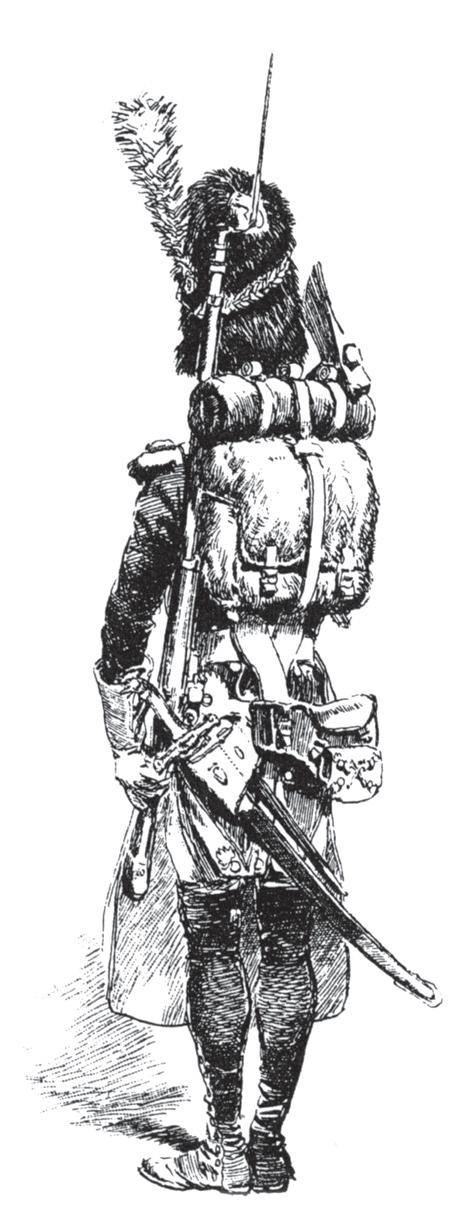
7.0.2 The Coalition: Coalition player’s forces are composed of two armies: the Allied army under Wellington (comprised of British, Dutch/Belgian, Brunswicker, Hanoverian and Kings German Legion units) and the Prussian army under Blücher.
7.0.3 Levels of Victory: Scenarios contain different levels of victory: decisive, major and minor. A decisive victory is one that spells the end of fighting in Belgium. A major victory is one that significantly affects the strategic situation. A minor victory is provided to allow players to claim a win in what is essentially a draw.
7.0.4
Battles
7.1 Quatre Bras: Crisis at the Crossroads
7.2 Ligny: Prussians at Bay
7.3 Wavre: An Earthquake Had Engulfed Him
7.4 Waterloo: Where Blücher Beat Napoleon
7.0.5 The Campaigns
7.5 June 16 Campaign: The Emperor Strikes
7.6 June 18 Campaign: Fall of Eagles
7.7 The Hundred Days Campaign
© 2021 Compass Games, LLC.

Napoleon’s Marshal Ney, with the Armée du Nord’s advanced guard, was tasked with capturing the crucial crossroads at Quatre Bras. One of the two roads that met at Quatre Bras was the major North-South road leading from Charleroi (where the French army was attacking), to Brussels (the Allied supply base). The second road ran West to East, from Nivelles, where much of the Wellington’s army was assembling, through Ligny, where the Prussians were deployed, to Namur, the Prussian supply base. Wellington had planned to support Blücher at Ligny using this second road, with Blücher deploying his forces appropriately. Napoleon ordered Ney to use the same road to make the same march, arriving on his left to envelop the Prussian army. Instead, Ney and Wellington spent the sixteenth preventing each another from doing either. The following day, Wellington withdrew northwards under cover of thunderstorms, matching his Prussian allies march, and consolidating his scattered army near Waterloo.
2. Duration: 4 turns
3. Victory Conditions: Players win a major victory by breaking the opposing army. If neither player wins a major victory, a minor victory goes to the player scoring the most victory points (ties go to the Coalition player). Victory points are scored for each of the following:
+1 per terrain card controlled at the end of turn 4
+1 per enemy unit eliminated
+1 per demoralization inflicted on the opposing player
+1/2 for each opposing player’s playing card removed from play due to melee
+4 if Wellington is eliminated. In addition, a French minor victory becomes a French major victory if this occurs.
a) French I Corps: The French player may make an entry check every turn beginning on turn 3 to see if I Corps arrives at Quatre Bras. I Corps reinforces the West reserve if it passes an entry check.
b) First Player: The French player begins the game as the First Player. During the Preparation Step of turns 1-2, the Coalition player may choose to become First Player for the remainder of the game and remove 1 demoralization (turn 1 gains a Preparation Step for this scenario). During the Preparation Step of turn 3, if the Coalition player has not already chosen to become the First Player, this happens automatically (however, with no removal of demoralizations).
Design Notes: Why no Decisive victory at Quatre Bras?
As important as it was, the battle at Quatre Bras could not have decided the campaign without victories elsewhere. Like Grouchy’s combat at Wavre, this is not the main event.
© 2021Compass Games, LLC.
After Zieten’s fighting withdrawal from the Sambre river, Marshal Blücher, convinced that Wellington would reinforce his right wing, drew up his army behind the town of Ligny. Two assumptions ended up dooming the Prussians: Wellington would not arrive (finding himself in a scrap at nearby Quatre Bras), and Bülow’s IV Corps, missing a march the day before, would not arrive either. Napoleon, having maneuvered his enemies into just the kind of fight he wanted, had problems of his own.

One was the mysterious behavior of d’Erlon’s I Corps, vacillating between supporting the fight at Quatre Bras and the fight at Ligny, and in the end supporting neither. Second, for most of the morning, Napoleon assumed that Ney’s II Corps was approaching the Prussian left flank to deliver a coup de grace. When neither I nor II Corps arrived, the Imperial Guard was sent forward at nightfall to break the wavering enemy. The Prussians could not hold against the veteran French elites, but they managed to avoid complete disintegration. Under cover of darkness, they abandoned the field, bearing a badly wounded Blücher with them, marching, not for Namur as Napoleon supposed, but northwards, to maintain contact with Wellington.
1. Stacking: 4 units
2. Duration: 4 turns
3. Victory Conditions: A decisive victory can only be won by breaking the opponent’s army. The French player wins a major victory by gaining 8 more victory points than the Coalition player at the end of the game (the historical result). Players score points for each of the following:
+2 per terrain card controlled at the end of turn 4
+1 per enemy unit eliminated
+1 per demoralization inflicted on the opposing player
+1/2 for each opposing player’s playing card removed from play due to melee
+2 if Marshal Blücher becomes HdC during the scenario (French player only)
+4 if Marshal Blücher is eliminated (French player only)
The Coalition player wins a minor victory if the French player scores between 1 and 7 more Victory Points than the Coalition player. Any other result is a Coalition major victory.
a) The Old Guard: If the Old Guard is in a Wing in which the French Player declares an attack, and the battle doesn’t end with a flanked card being placed on the Coalition side of the Front Line card, the French player gains 1 demoralization.
The French player gains 1 demoralization each time the Old Guard is disrupted or eliminated.
Old Guard penalties inflict a maximum of 1 demoralization per turn: If the Old Guard retreats from a wing, the French player does not suffer two demoralizations (one for becoming disrupted and one for no Flanked card placed on the Coalition side of the table).
b) French I Corps: The French player may make an entry check every turn beginning on turn 3 to see if I Corps arrives at Ligny. I Corps reinforces the East reserve if it passes an entry check.
c) Prussian IV Corps: The Coalition player may make an entry check every turn beginning on turn 3 to see if IV Corps arrives at Ligny. IV Corps reinforces the Prussian reserve if it passes an entry check.
“Grouchy was as useless to the army on that fatal day as though an earthquake had engulfed him and removed him from all participation in human affairs.”- Napoleon
Following the bloodbath at Ligny, Marshal Grouchy was tasked with pursuing the fleeing Prussian army. With the battered III and IV Corps (30,000 men), he got off to a late start on the 17th, and did not realize until quite late in the day that the Prussian army had retreated, not along their supply line through Namur, but north to Wavre, so as to remain within supporting distance of the Anglo-Allied army. As the guns began to fire at Waterloo, Marshal Grouchy was sitting down to lunch. He was urged by General Gérard, commanding IV Corps, to march to the sound of the guns. Grouchy ignored him. He would not begin his assault on the Prussians behind the Dyle river until 4:00 p.m.
1. Stacking: 4 units
2. Duration: 4 turns
3. Victory Conditions: A player gains a Major victory by breaking the opposing army. If neither army breaks, a Minor victory is won by the French if they have scored 4 more victory points than the Coalition player at the end of the game. Any other result is a Major victory for the Coalition player. Victory points are scored for each of the following:
+1 per demoralization inflicted on the opponent
+1 per opposing unit eliminated
+1/2 per playing card removed by the opponent from play due to melee
a) Interfering with the March of II Corps: Once Grouchy decided not to march to Waterloo on the morning of the 18th, his best hope for influencing the campaign was to break into the Prussian rear at Wavre, disrupting and delaying the movement of Prussian troops (though not in play, the Prussian II Corps is “in the area” of the Prussian reserve, in road march towards Waterloo). On turn 1, French units in the Prussian rear will have maximum effect on the II Corps march columns. After that, breakthroughs are closing the barn door after the horse has gone.
On turn 1, all French breakthrough attacks inflict double the printed number of demoralizations. Demoralizations inflicted by the placement of flanked cards are not affected by this special rule.
“You remember, Maria, Waterloo was the battle where Blücher beat Napoleon!” - the author’s Austrian grandfather to his grandmother.
Waterloo, apart from its place of prominence in Napoleonic history, is a unique battle, full of twists and turns. It began, early on June 18th, with Wellington’s Anglo-Allied army forming a few miles outside of Brussels, its supply base. After the action at Quatre Bras on the 16th, Wellington had finished consolidating his army (minus 17,000 men, holding a distant position at Hal). Wellington concealed much his army behind a gradual slope and fortified two soon-to-be-famous chateaus: La Haye Sainte and the Chateau de Hougoumont. Meanwhile, Marshal Blücher (the Prussian commander so beloved by German-speaking schoolchildren), was marching East from Wavre to Wellington’s support. By early afternoon, Bülow’s IV Corps was near the battlefield, with I and II Corps filling the roads behind. The battered III Corps protected their rear from pursuing French forces at Wavre.
Napoleon, meanwhile, was delighted that Wellington had turned to fight. He was confident that he had shattered the Prussian army at Ligny two days earlier, and methodically prepared his attack. Instead of striking at dawn, he waited for the ground, soaked by an overnight rain on the 17th, to dry enough that his cavalry could charge, and his artillery be used to full effect. It was not until noon that French guns, massed in the center of the French line, opened fire, followed by attacks on Wellington’s right against Hougoumont and against his left by I Corps. A tremendous cavalry battle ensued, as Allied cavalry shattered I Corps’ columns, only to be cut to pieces in turn by the counter-charging French. Around 4:00 p.m. Marshal Ney was informed that the Allies were retreating (not true), and launched a “pursuit” with the French cavalry reserve. This massive charge eventually drew in the guard cavalry, along with the III and IV Cavalry corps… 9,000 sabres in all. Ney’s charge, unsupported by infantry or artillery, drove up the slope only to break against British infantry, formed in squares at its summit.
As Wellington’s army wavered under the French onslaught, Bülow’s IV Corps charged from the Bois de Paris, a forest on the eastern edge of the battlefield. Napoleon dispatched VI Corps, followed by the Young Guard and elements of the Old Guard to keep the Prussians from enveloping his army. The final chapter came late in the day (7:30 p.m.) with another charge by Napoleon’s vaunted Imperial Guard. Their destruction, coming at the same time as a Prussian breakthrough at Plancenoit, inflicted the fatal ninth demoralization on the Armée du Nord, ending, for good this time, the Napoleonic Era.
1. Stacking: 4
2. Duration: 5 turns
3. Victory Conditions: A player gains a Decisive victory by breaking the opposing army. If neither army breaks, a Major victory is won if one player scores 8 more victory points at the end of the game than the other player. A Minor victory is won if either player scores 1-7 more victory points than the other player (the Coalition wins ties). Victory points are scored for each of the following:
+1 per demoralization inflicted on the opponent
+1 per opposing unit eliminated
+1/2 per playing card removed by the opponent from play due to melee
a) The Prussians Arrive: Neither players’ units may enter the Bois de Paris Reserve or Wings D & E until the beginning of turn 3.
Turn 3: Wing E opens, and Prussian units (only) may enter the Bois de Paris. Units may not move between the Allied reserve and the Bois de Paris reserve.
Turn 4: Wing D opens, and units may move between the Allied and Bois de Paris reserves.
b) Special Characteristics of the Prussian Army
1. Flanked cards placed on the Coalition side of Wings D and E do not affect the Coalition demoralization level.
2. The Bois de Paris Reserve may not be the target of French breakthrough attacks.
3. Coalition forces in Wings D and E are unaffected by the Coalition demoralization level (starting hand size is not reduced if the Coalition demoralization level is at 5 or more).
c) Movement of Coalition Forces: Allied units may not enter the Bois de Paris Reserve. Prussian units may enter the Allied Reserve. In order for an Allied Leader to end its movement phase in a Wing, an Allied unit must be present. In order for Blücher to end his movement phase in a Wing, a Prussian unit must be present. Blücher may only issue orders from the Bois de Paris Reserve.

d) Coalition HdC Recovery: Prussian II and IV Corps units on the HdC Card may only rally to the Bois de Paris Reserve. Prussian I Corps units on the HdC Card may rally to either the Bois de Paris or Allied Reserves. Allied units on the HdC Card may only Rally to the Allied Reserve.
e) The Old Guard: If the Old Guard is in a Wing in which the French Player declares an attack, and the battle does not end with a flanked card being placed on the Coalition side of the table, the French player gains 1 demoralization.
The French player gains 1 demoralization each time the Old Guard is disrupted or eliminated.
Old Guard penalties inflict a maximum of 1 demoralization per turn: If the Old Guard retreats from a wing, the French player does not suffer two demoralizations (one for becoming disrupted and one for no Flanked card placed on the Coalition side of the table).
f) First Player: The French player begins the game as the First Player. During the Preparation Step of any turn prior to turn 4, the Coalition player may choose to become First Player for the rest of the game, and remove 1 demoralization (turn 1 gains a Preparation Step for this scenario). During the Preparation Step of turn 4, if the Coalition player has not chosen to become the First Player, this happens automatically (however, with no removal of demoralizations).
Napoleon’s Eagles: The Hundred Days includes three campaign games: The Emperor Strikes (June 16th), Fall of Eagles (June 18th) and The Hundred Days Campaign. Each day’s scenarios may either be played simultaneously, side by side, or sequentially one after the other.
Simultaneous Games, Separate Battles: When playing a campaign game simultaneously, the different scenarios’ reserves are not linked (the French East reserve at Waterloo does not link with the French West reserve at Wavre, for example). Additionally, flanked cards in one scenario do not affect the other (a flanked card in Wing B at Quatre Bras has no effect on a battle in Wing C at Ligny). Demoralizations inflicted, and units which are HdC must be tracked separately for each battle (HdC units at Ligny may only rally to reserves at Ligny).
Additional Decks of Playing Cards: Because melee cards eliminated in one scenario of a campaign game will affect play in the other, owners of Napoleon’s Eagles: Storm in the East are encouraged to use the playing cards from that game to provide separate decks for the campaign game (one per scenario). Alternatively, up to 4 players can play the campaigns in teams of 2 players per side. Each player directs one of the battles (Ligny or Quatre Bras on the 16th for example), using their own deck of playing cards.
© 2021 Compass Games, LLC.

The Battles of Quatre Bras and Ligny
June 16th was Napoleon’s best chance to win the Hundred Days campaign. He had caught the Prussians without a quarter of their army and had deprived them of Wellington’s support. A crushing defeat on the 16th would have left Wellington at Napoleon’s mercy. Unfortunately for the Emperor, things did not all go his way. Napoleon was unable to clinch his victory at Ligny, which proved fatal at Waterloo.
If played simultaneously, both Quatre Bras and Ligny begin on the same turn. If playing sequentially, play Ligny first.
1. Victory Conditions: If either player breaks the opponent’s army at Ligny, they win a Decisive victory. If neither army breaks at Ligny, score campaign victory points as follows (higher total wins):
3 Points: Major victory at Ligny
2 Points: Minor victory at Ligny (Prussians only)
2 Points: Major victory at Quatre Bras
1 Point: Minor victory at Quatre Bras
2. Campaign Results: Subtract the total number of campaign victory points scored by the player with the lower total from the player with the higher total. The result determines the quality of that player’s victory:
4+ campaign victory points (Major Victory): After inflicting crushing losses at both Ligny and Quatre Bras, the victor will fight on the 18th with a significant advantage.
1-3 campaign victory points (Minor Victory): The victor’s opponent has been driven from the field, but left mostly intact. Fighting will continue on the 17th. (Historical Result)
0 campaign victory points: A stalemate at Ligny and Quatre Bras means that both armies will limp to their fateful rendezvous at Waterloo and Wavre.
a) French I Corps: The French I Corps may reinforce either the West or East reserve. When playing the battles sequentially, if I Corps appears at one battle, it may not appear at the other. A player may choose not to make entry checks for I Corps’ arrival at Ligny if desired (so as not to
The Battles of Waterloo and Wavre
Napoleon’s goal in attacking the combined armies in Belgium was to destroy them in detail before falling on Schwartzenberg’s Austrians to the south. If unable to do that, even if his army survived intact, it is hard to see how he could have held out in the long run. The Allies had learned how to fight the Emperor in 1813-14, and their numerical superiority was significant. That said, the Emperor was the Emperor. He had made a career pulling rabbits out of hats. Certainly, all of Europe breathed a collective sigh of relief when l’Empereur was out of France and on his way to St. Helena.
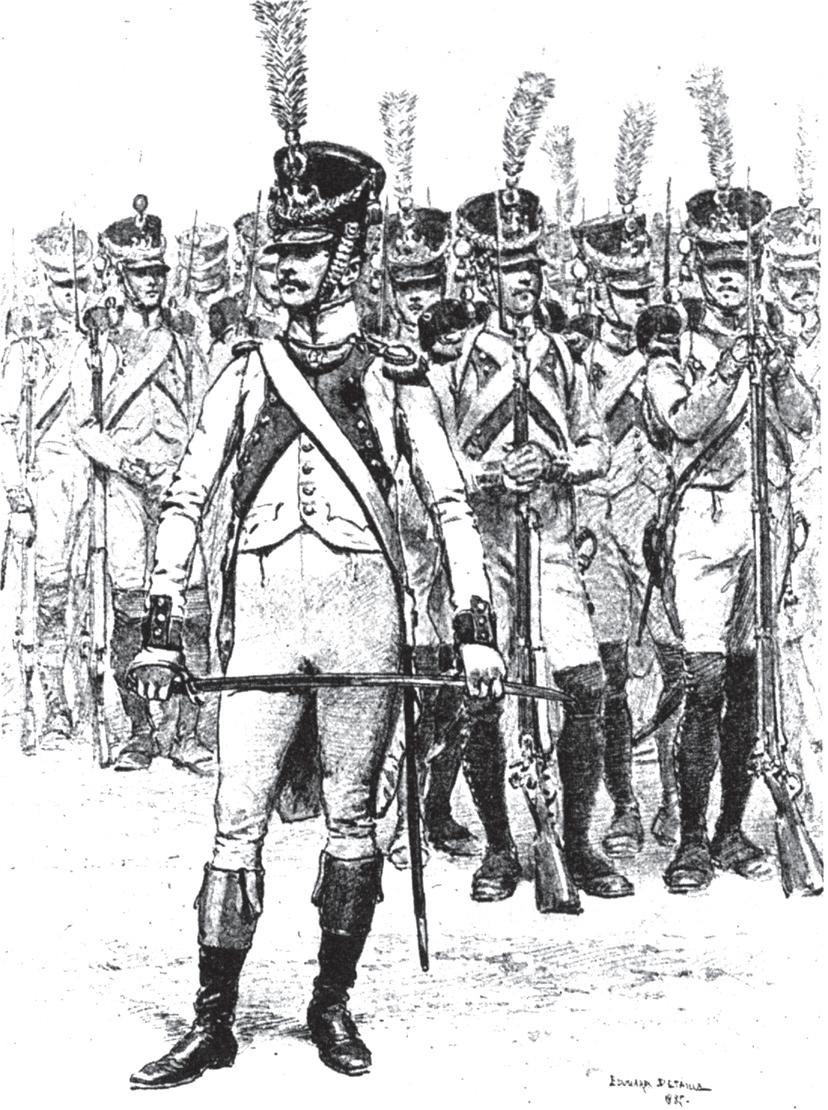
If Waterloo and Wavre are played sequentially, Wavre is played first. If the battles are played simultaneously, side by side, Wavre begins one turn later than Waterloo (see special rule a below).
1. Victory Conditions: If either player breaks the opponent’s army at Waterloo, they win the June 18th scenario decisively. If neither army breaks at Waterloo, score campaign victory points as follows (higher total wins):
3 Points: Major victory at Waterloo
2 Points: Minor victory at Waterloo
2 Points: Major victory at Wavre
1 Point: Minor victory at Wavre
2. Campaign Results: Subtract the total number of campaign victory points scored by the player with the lower total from the player with the higher total. The result determines the quality of that player’s victory:
4+ campaign victory points (Major Victory): The losing side retreats, ending the campaign in Belgium. The victor is too bloodied to mount an effective pursuit, but, strategically has gained the upper hand.
1-3 campaign victory points (Minor Victory): The victor’s opponent has been driven from the field, but left mostly intact. The fighting will continue on the 19th.
0 campaign victory points: A stalemate means that Napoleon’s aims for the Belgian campaign have been thwarted. All armies will need some days to recover.
a) Late start at Wavre: The opening bombardment at Waterloo commenced around 11:30 a.m. (turn 1), but Vandamme did not arrive at Wavre until between 3:00 and 4:00 p.m. (turn 2).
When playing both battles simultaneously, Wings F and G are closed on turn 1 of the game. Coalition and French units may not enter the wings while closed. They open on turn 2.
b) Demoralizations Inflicted on the Coalition Army at Wavre: Breakthrough attacks at Wavre may disrupt Prussian units reinforcing Waterloo. On turn 2, French breakthrough attacks inflict double the number of demoralizations.
When playing the battles sequentially, players must note how many demoralizations the French player inflicts via breakthrough attacks on turn 2. Each such demoralization will cause one Prussian II Corps unit to enter play disrupted at Waterloo. The Coalition player chooses which reinforcing units are affected. If an already disrupted unit is chosen, it is eliminated instead.
When playing the battles simultaneously, each demoralization the French player inflicts via breakthrough attack at Wavre on turn 2 immediately disrupts one reinforcing Prussian II Corps unit. The Coalition player chooses which units are affected. If an already disrupted unit is chosen, it is eliminated instead.
The Hundred Days campaign consists of the campaign games of the 16th (scenario 7.5.1) followed by the 18th (scenario 7.5.2). The campaign may end on the 16th if the Coalition wins decisively at Ligny, otherwise the battles of the 16th set the stage for the final battles on the 18th.
1. Ending the Campaign on the 16th: The Coalition player wins the campaign outright if the French army is broken at Ligny. If there is no outright victory on the 16th, play continues, with the following adjustments:
2. Results of the Battle at Ligny
a. The French break the Coalition army: Wavre is not played on the 18th, and no Prussians arrive at Waterloo. The shattered Prussian army is assumed to retreat towards Namur instead of Wavre, with Grouchy in hot pursuit. Wellington is on his own!
b. Major French victory at Ligny (historical result): Play Wavre and Waterloo as normal.
c. Major Coalition win at Ligny: the French can not play 25 value cards as melee cards at Wavre. The Prussians beat back the French, inflicting heavy casualties. Grouchy is unable to press his attack at Wavre vigorously.
d. Any other result at Ligny: neither player can play 25 value cards as melee cards at Wavre. The bloodbath at Ligny leaves both armies drained.
a. French Major Victory at Quatre Bras: the British Cavalry, 2nd Dutch/Belgian Division and British 1st Division begin Waterloo disrupted. Marshal Ney has a glorious day at the crossroads. The British cavalry is mauled acting as a rearguard.
b. French Minor Victory at Quatre Bras: the 2nd Dutch/Belgian Division and British 1st Division begin Waterloo disrupted. Marshal Ney presses the Allies vigorously, forcing their retreat.
c. Major Coalition Victory at Quatre Bras: the French IIIC cavalry corps and 5th & 9th Divisions begin Waterloo disrupted. Fierce Allied counterattacks break Ney’s force. The French are driven from the field with heavy losses.
d. Minor Coalition Victory at Quatre Bras: (historical result). Play Wavre and Waterloo as normal. Marshal Ney feeds units in piecemeal at Quatre Bras, an ominous preview of what is to come.
5. Victory Conditions for the Campaign Game: Use the victory conditions outlined in 7.6, The Fall of Eagles.
The battles featured in Napoleon’s Eagles: The Hundred Days are among the most famous in history, certainly for the English-speaking world. Waterloo is an incredibly complicated and compressed battle. This is partly because of its late start (the French did not begin their attack until noon) and partly because of its dramatic narrative (both players must switch between the offensive and defensive in the same battle). On turns 1 and 2 Napoleon must go all out to try to break the Allies. Once the Prussians arrive, the tide quickly turns against him. As Wellington, it’s a delaying game on turns 1-3. A survival game. If he can hold until turn 4, he must switch quickly to the offense. An important decision for the Coalition player is when to take over the role of first player... demoralization is an instant win. If the Coalition is the second player and the French player is able to break through in a wing and inflict that ninth demoralization, it does not matter that the Prussians could have broken the French in their wing on the same turn. The game ends before they get a chance to attack.
Wavre is always the awkward stepchild in the battles of the Hundred Days. It is a battle that should not have taken place, and, if it had to take place, should have started earlier. That said, if we assume that Grouchy could have interrupted the movement of the Prussian troops to the front, we have the makings of a unique scenario for Napoleon’s Eagles. The French player must inflict damage on turn 1, with his opportunities vanishing along with the setting sun. Thielemann has to hang on with not a lot to work with. As an optional rule, start the battle one turn earlier to see what might have been…
Ligny is a straight up slugging match between two massive armies, reminiscent of Borodino. Napoleon’s force is more nimble, with better cavalry, better command and, of course, the Imperial guard. The Prussians have some good ground (Ligny in particular), and a number of strong, tenacious infantry units. They are saddled with inexperienced Landwehr and relatively fragile cavalry, but if the French get an unlucky hand, the Prussians can do significant damage.
Quatre Bras is the introductory scenario, quick to set up and play, but with some interesting wrinkles. In a way, it’s a mini-Waterloo. Ney needs to inflict casualties before Wellington’s powerful reinforcements arrive and launch their counterattack. The fact that the Dutch-Belgians can not defend both wings on turn 1 is unique to the system. This is intentional, and makes for a tense game as the allies. If Ney deploys in both wings, the allies will take demoralizations on turn 1 and lose one or two terrain features. Do not give up! Help is on the way.
Card play is at the heart of this game, and it can come at you sideways. One of our playtesters said “it feels like I’m always responding to things that I can’t control.” As a
© 2021Compass Games, LLC.
















player, go in knowing that combats can stalemate or go very badly very suddenly. There is a premium on keeping your composure. Over the course of a game, opportunities will present themselves. A bad hand of cards can seem like a death sentence (and sometimes it is), but you don’t know what your opponent has drawn. Let each hand play itself out before you give up on it. Let the story unfold. Melee cards and cavalry can save you unexpectedly. Do not retreat except as a last resort or if you are in danger of being horribly overrun (remember, your units are exhausted and disrupted when they retreat). The new Desperate Defense rule gives players a way to deal with overwhelming attacks, but it comes at a price. On the attack, look for weaknesses in your opponent’s hand, and manage your resources to allow you to pounce if the opportunity presents itself. That said, the truly historic breakthroughs come when you have managed to preserve your units (ready and full-strength) while routing the enemy.
Players familiar with Napoleon’s Eagles: Storm in the East will notice that, where that game featured corps-sized units, this game breaks corps down into divisional or multidivisional units. I made that choice with much trepidation, and against the advice of my mentor, Kevin Zucker, who adamantly feels that units should reflect actual organizational echelons. Corps sized units, which work beautifully for the massive armies of 1813, are too broad for 1815, where the Anglo-Allied army had only 3 corps, and those could only loosely be defined as an organizational echelon. Wellington himself deployed them with little regard for their corps affiliation. Falling all the way down to the divisional level would have meant a much more massive game (in terms of unit cards) than I wished. Napoleon’s Eagles is meant to be a fast-playing game: quick to set up, and able to be played anywhere. I settled on the presentation you see here. For the Prussian army, corps are divided as neatly as possible into threes: two infantry brigades plus cavalry. For the AngloAllied army, corps are broken down by division (echelons higher than that are nearly useless as an organizational instrument). For the French army, corps are divided into two units: the first composed of an infantry division plus the corps cavalry, the second two divisions plus the corps artillery.
Artillery was also affected by the scale change. In Storm, each artillery rating represented 36 guns. For The Hundred Days, each artillery rating represents 24 guns. Guard artillery ratings represent 12 guns in The Hundred Days, vs. 18 in Storm in the East
The Hundred Days introduces “gray” infantry and cavalry ratings to the game. Units in Storm in the East which lose their symbols (like Tauentzien’s IV Corps) should be assumed to have gray infantry and cavalry symbols on their disrupted sides when retro-fitting these rules. A unit losing its rating means that it was raw (in the case of the Landwehr), elite but undersized (like the Prussian Royal Guard in Storm

in the East) or less motivated than line troops (in the case of the Dutch-Belgian and Brunswick units). Units with a gray infantry or cavalry symbol represent a middle range between untrained troops like the Russian militia at Borodino and line infantry. This qualitative difference is also reflected in Manpower ratings, which is why the Landwehr-heavy Prussian army of 1815, though more numerous than the French in terms of bodies, has lower overall manpower ratings. Unit Strengths, which are not affected by morale differences, are a better representation of raw numbers.
Finally, game designers seem to feel that a Napoleonic game just is not complete until Marshal Ney has been given a special rule such as “If Ney rolls a 2, he moves in a random direction.” Admittedly, The Hundred Days were not Ney’s best, but they weren’t Soult’s, Grouchy’s or Napoleon’s either. Ney fought bravely at Waterloo, nearly breaking Wellington’s army in the early afternoon (Napoleon refused to release the Old Guard, and the chance passed). In any event, Ney was punished for his errors. Six months after Waterloo, he went before the firing squad (or, as legend has it, escaped to become a school-teacher in South Carolina; possibly a worse fate). Not wishing to add to his woes, the designer has taken the unprecedented step of issuing no special rules for the Bravest of the Brave, beyond his initiative being available only on attack. I trust he would approve.
The following is a play-through of the first two turns from scenario 7.1: Quatre Bras. We recommend that you set up the units and play along with the example.
TURN 1
Preparation Step
This is skipped on turn 1.
Movement Step
The French player is the first player at the start of this scenario. The Coalition can claim first player status at any time after that, and becomes the first player automatically on turn 3.
The French player moves the 5/9th Divisions of II Corps to Wing A and the Guard Cavalry to Wing B. Ney remains in the West Reserve to support both wings with his orders rating (2.3.1). The Coalition is at a disadvantage on turn 1: they can’t protect both wings, so the French moves guarantee a breakthrough attack against the unprotected Allied reserve. The best the Coalition can do is attempt to reduce the damage. Prince William and the 2nd Dutch Belgian division move from the Allied Reserve to Wing A to fight for the Bossu Wood.
Battle Declaration Step
The French player declares attacks in both wings. Both frontline cards are flipped over, with the attack arrows pointed towards the Coalition player.
Battle Resolution Step
WING B
In Wing B, the French Guard Cavalry advances into the lightly defended Gemiancourt Farm and village of Pieraumont.
The French player decides to begin with the attack in the unoccupied Wing B, since that will flank the Coalition forces in Wing A later in the turn. There are no defending combat units in Wing B (the garrisoned terrain card does not count as a combat unit), so the Coalition captures both terrain cards (moves them to the French side of the Wing B frontline card). Note the text on the Gemiancourt Farm terrain card: if captured by the French, it is flipped over. The French player places a flanked card on the Coalition side of the frontline card and inflicts one demoralization on the Coalition player (6.11.2).
French Breakthrough:
The Guard Cavalry will perform a breakthrough attack on the exposed Allied Reserve. The French player makes a breakthrough check (6.12.1), drawing a card and consulting its breakthrough section. The card
drawn displays “Disrupt 2(1)” beside the cavalry symbol, meaning the Guard cavalry becomes disrupted and inflicts 2 demoralizations on the Coalition player (the parenthesized result is only used by cavalry defending against a breakthrough attack). Because there are no units in the Allied reserve to defend against the breakthrough, the French player inflicts two additional demoralizations. Combined with the demoralization inflicted at the end of battle resolution, the Coalition takes 3 demoralizations. A demoralization card with the 3 result showing is slipped under the Coalition player’s deck.
In Wing A, the French 5/9th Divisions launch their assault. The 2nd Dutch-Belgian Division, led by Prince William, has been flanked by the advancing French cavalry in Wing A. They are defending the Bossu Woods, which should have its Hold Icon face up (2.2.4).
Draw Cards:
Both player draw four cards (basic starting hand). The Coalition player draws one additional card for Prince William’s leadership rating, but one less card due to the Flanked card in wing B, so the Coalition player’s hand will be 4 cards. The French player draws one additional card for Marshal Ney’s orders rating, for a starting hand of 5 cards.
French Hand: Black A,9 Red 3,6,7
Coalition Hand: Black 10, Red 6,8,15
Pre-Battle Checks:
The 5/9th has 2 points of artillery, reduced to 1 by the text of the Bossu Wood terrain card. The French player peforms an artillery fire check (6.3), drawing a Red 9 which shows that 1 point of artillery inflicts 1 hit. The Coalition player surrenders the Bossu Wood terrain card. The Coalition player has no artillery. Prince William must make a leader elimination check (6.4). Both players draw a card from their deck and compare the elimination symbols: each card has a symbol, but they do not match, and they are different colors: No effect.
Opening French Attack:
The French player will open the attack (as indicated by the arrow on the frontline card), and plays a Red 7 (+1 for the 5/9th’s Manpower rating for a total of 8). The coalition player plays a red 8, defeating the attack.
Coalition Attack:
Because the attack was defeated, the coalition player plays the next attack, choosing a Red 6. The French player plays a Red 6 as well, defeating the attack.
© 2021Compass Games, LLC.
French Attack:
The French player plays a Black Ace (the +1 manpower rating brings the attack to a 2). The Coalition player defends with a Black 10, defeating the attack.
Coalition Attack:
The Coalition player plays a red 15. The French player defends with a Red 3 (+1). The Coalition attack inflicts 11 damage on the French player’s units! The 5/9th exhausts (it has an infantry symbol, see 6.8.1), accounting for 3 points of the damage, and disrupts, accounting for another 9 (equal to it’s strength rating). All damage has been accounted for.
Coalition Attack:
Since the attack was not defeated, the Coalition player may attack again, but is out of cards. According to rule 6.11, if an attacking player has no cards in hand, the battle ends in a draw. All cards are discarded and the battle is over.
Preparation Step:
Both players shuffle their discarded cards into their decks. Exhausted units are readied. The Allied Reserves is flipped to its out of command side since it was subjected to a successful breakthrough attack in Turn 1 (6.12.3). Reinforcements arrive for both players. The French III Cavalry Corps and 6th Division are placed in the West Reserve. Lord Wellington, the 5th Division and the Dutch-Belgian Cavalry are placed in the Allied Reserve.
Movement Step:
The Coalition decline to become 1st Player, so the French player moves the newly arrived 6th to Wing B, and the III Cavalry Corps to Wing A, where it joins the disrupted French 5/9th. The disrupted Guard Cavalry moves back to the West Reserve, joining Marshal Ney. The Coalition player moves Wellington plus the two new arrivals to Wing B, while Prince William and the 2nd Dutch-Belgian division remain in Wing A (note that, because the Allied Reserves is out of command, Wellington can’t use his orders rating from there).
Battle Declaration Step:
The French player chooses to attack in Wing A only. The Coalition player has the option of attacking in Wing B, since the first player declined to do so, and does. The Wing A frontline card is flipped so that its arrow points towards the Coalition player, while the Wing B frontline card is flipped so that its arrow points towards the French player.
Battle Resolution Step:
The French player chooses to resolve the attack in Wing A first, hoping to support the battle in Wing B by flanking Wellington. Since the arrow on the frontline card is pointing towards the Coalition player, the French has the opening attack.
In Wing A, the disrupted French 5/9th Divisions advance out of the Bossu Woods. The terrain card is flipped over, so that its Advance Icon is showing (2.2.4). Their opponent remains the 2nd Dutch Belgian Division, led by Prince William.
Draw Cards:
Both players draw 5 cards: 4 +1 for Ney’s Orders (France), 4 +1 for Prince William’s leadership (Coalition).
France: Black 5,8,15 Red 15,25
Coalition: Black 5,7,10 Red 2,9
Pre-Battle Checks:
The disrupted French 5/9th has an artillery rating of one. The French player makes an artillery fire check (6.3) which has no effect. Both players draw a card and check for matching symbols to see if Prince William is affected. Again, no effect.
Opening French Attack:
With pre-battle checks finished, the French player attacks with a Black 8. The Coalition plays a Black 10, defeating the attack.
Coalition Attack:
The Coalition player attacks with a Red 2. The French player plays a Red 15, defeating the attack.
French Attack:
The French player attacks with a Black 15. The Coalition player defends with a Black 7 and a Black 5 for a total of 12. Three points of damage get through the defense. The Coalition player exhausts the 2nd Dutch-Belgian division, accounting for the 3 points of damage (6.8.1). Because the attack wasn’t defeated, the French player attacks again.
French Attack:
The French player attacks with a Black 5. The Coalition player does not retreat, after which the French player decides to charge with the III Cavalry Corps. A card is drawn (Red 20) and a charge check is made (the charge section of the card says “retreat”). The value of the charge card (20) is added to the value of the attack card (5) for a total attack of Black 25. The III Cavalry Corps retreats (6.10.2). It is disrupted and moved to
© 2021 Compass Games, LLC.
the West Reserve. The Coalition player, unhappy about not having retreated earlier, must now deal with the attack. It doesn’t have any black cards, so discards its Red 9. The 2nd Dutch-Belgian cannot exhaust (it did that earlier). It disrupts for 6, then disrupts again for 3 and is eliminated. The Coalition wing has no combat units left (Prince William doesn’t count), so the battle ends with a French victory. Prince William is moved back to the Allied reserve. A Flanked card is placed in Wing A, inflicting one demoralization on the Coalition player (bringing its total to 4), and the French player declares Breakthrough attacks.
French Breakthrough:
The 5/9th makes a breakthrough attack on the undefended Allied reserve, drawing a card and checking its breakthrough section. For an infantry unit the card shows the result “exhaust/1”. The 5/9th is exhausted and inflicts one more demoralization on the Coalition player (for a total of 5). The 5 demoralization level card is placed under the Coalition deck. Note that from now on, the Coalition player will draw 1 less card during battle because it’s at 5 or more demoralizations.
In Wing B, Lord Wellington leads his hard-marching columns to re-take the village of Pireaumont and the Gemiancourt Farm. He has a combined arms force of the British 5th Reserve Division and the Dutch-Belgian Cavalry. Opposing him is the newly arrived French 6th Division of II Corps, holding the village and the farm. Note that the farm has a Terrain Icon (2.2.4) that only allows the Coalition player to flip it to its garrisoned side. Since the Coalition player is attacking, Pireaumont is flipped so that its Hold Icon is displayed, giving the defending infantry +1 manpower and the enhanced melee ability (2.3.14)
Draw Cards:
Both players draw 5 cards: 4 +1 for Ney’s Orders (France), 4 +2 for Lord Wellington’s leadership +1 for combined arms (6.2.1) -2 for being both Flanked and demoralized (Coalition).
Coalition: Black 8,9,20 Red 5,20
French: Black Ace,2,25 Red 4,15
Pre-Battle Checks:
The Coalition performs an artillery fire check for the 5th Division’s 1 artillery (no effect). Both players draw a card and check for matching symbols to see if Lord Wellington is affected (no effect).
Opening Coalition Attack:
The Coalition player leads with a Black 9 (+1 Manpower). The French defend with a Black 25. The attack is defeated.
French Attack:
The French player attacks with a Red 4 (+2 Manpower). The Coalition plays its Red 5 (+1) defeating the attack.
Coalition Attack:
The Coalition payer attacks with a Black 8 and declares a charge with the Dutch-Belgian Cavalry after the French player declines to retreat. The charge card is a Red 25. The charge check for cavalry is “HdC” (meaning Hors de Combat (6.14)). The attack total is now Black 33. The Coalition cavalry unit is moved to the Hors de Combat card. The French player exhausts the 6th Division allowing a Red 15 to be played as a Melee card (6.6). A melee card always defeats an attack, regardless of color or value. The Coalition charge is defeated. The melee card is removed from the game (not simply discarded), and the French player draws a replacement (a Red Ace).
French Attack:
The French plays a Black Ace (+2 manpower). The Coalition plays a red 20, using Wellington’s initiative (2.3.4) to switch its color from Red to Black. The attack is defeated.
Coalition Attack:
The Coalition player attacks with its last card, the Black 20. The 6th Division, left with only an Ace, retreats (6.10.2). All cards are discarded, the 6th moves back to the reserve and disrupts (it is already exhausted). The two terrain cards are captured by the Coalition player and a Flanked card is placed in Wing B. One demoralization is inflicted on the French player.
Coalition Breakthrough Attack:
The 5th Reserve makes a breakthrough attack, drawing 1 card and checking its breakthrough section. The result is “exhaust 1”. It exhausts and inflicts 1 demoralization on the French. The disrupted Guard Cavalry decides to defend against the attack and makes a breakthrough check of its own. The result is “HdC 2(1)”. Because the cavalry is defending, the parenthesized result is used (6.12.2). The breakthrough attack is defeated. The Guard Cavalry would ordinarily be sent to the Hors de Combat card, but because it has the Guard symbol the result is no effect (2.3.13). The French army receives the one demoralization inflicted at the end of the battle, but the West Reserve will not be put out of command next turn because the breakthrough was defeated.
© 2021Compass Games, LLC.
This ends our example. Marshal Ney’s forces have done considerable damage to the Allied army by the end of Turn 2, but reinforcements are coming for the Allies, and the French have little likelihood of receiving more. By the end of Turn 4, victory in this game was calculated as follows:
All three terrain cards were held by the Coalition (+3 Coalition victory points)
The French had 3 eliminated units vs the Coalition’s 1 (net +2 Coalition Victory Points)
The French had 7 demoralizations vs the Coalition’s 5 (net +2 Coalition Victory Points)
The French lost 2 melee cards vs the Coalition’s 1 (net +.5 Coalition Victory Points).
The Coalition won a minor victory with 13.5 victory points to 7.
So what you’ve seen here was the best the French could do. On turns 3 and 4, the French fun was over, and the Allies paid them back with interest. Ney did manage to prevent his army from being broken, thus denying Wellington a Major victory.
